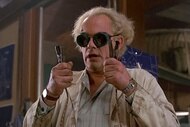Create a free profile to get unlimited access to exclusive videos, sweepstakes, and more!
Science Behind the Fiction: Should we worry about Crisis on Infinite Earth's antimatter wave?

DC Comics' Crisis on Infinite Earths is one of the most well-known and beloved story arcs in the vaunted publisher's universe. First published between April 1985 and March 1986, it tells the story of a cataclysmic event taking place across multiple universes.
The primary villain, the Anti-Monitor, uses a cascading wave of antimatter in an attempt to destroy each of the DC universe's many realities. His counterpart, the Monitor, with the help of Harbinger, brings together a team of heroes from across space and time to save all existence.
Nearly 35 years on, this seminal story has finally received a live-action adaptation on the small screen. While DC has had some hiccups in adapting its characters to film, the television series' attempts have been largely successful in creating fertile ground for these types of ambitious crossover events. In fact, The CW's slate of shows has made crossovers a yearly occurrence. And this year's, Crisis on Infinite Earths, promises to be the biggest yet.
This television event differs from its source material in some pretty substantial ways, but the key elements are the same: A wave of antimatter is making its way across the universe, threatening not just one reality, but all of them. Harbinger arrives in various universes and brings together a team (the central cast of The CW's series) to stop the end of reality.
It's the sort of story superheroes were made for. The best way to see what our favorite supes are made of is to raise the stakes, and there aren't any stakes higher than this. It succeeds by playing with concepts we are familiar with and taking them to the extreme. Antimatter exists, and when it interacts with standard matter, the results are impressive, to say the least. We may not have a league of superheroes, but is it possible we might be at the mercy of such a destructive end?
AMBER WAVES OF ANTIMATTER
When the wave first appears, it's in a flurry of gold-red light, lighting the sky with a portent of doom. Something is coming, a great cosmic tidal wave set to wash away everything in its wake. And almost as soon as it's seen, the end has come.
Something like this likely happened at the birth of the universe.
In 1928, physicist Paul Dirac crafted an equation that explained an electron's spin. But that equation had two solutions. One that explained electron spin and one that suggested the existence of a positron: Antimatter.
Four years later, Dirac's ideas were shown to be correct.
In the decades since this discovery, we've built massive machines, particle accelerators that smash bits of matter together so we can get a glimpse at the early universe.
So far as we can tell, when the universe first burst into existence during the Big Bang, there were nearly equal parts matter and antimatter. This is what we see in our particle accelerators.
That means, at the beginning of all things, there was an incredible war between matter and antimatter, with each particle annihilating its counterpart in an impressive explosion of energy.
If we could have been there to witness the event, it would have been one of immense devastation beyond our imaginings. Not even a team of superheroes, had they been there, would have been able to stop it. The laws of physics stop for no superperson.
This leaves us with a fundamental question: Why does anything exist at all? Given the symmetry of physics, shouldn't the matter and antimatter have reached equilibrium, leaving only a burst of energy in their shadow?
According to Michael Dine, a professor of physics at the University of California, Santa Cruz, the answer is no. But the reasoning is a little more speculative. "We now know that the symmetry is not quite exact, but our ideas about where the asymmetry comes from remain someone speculative," Dine said.
It's difficult to imagine what the early universe was like. But the best idea is that in the moments after the Big Bang, matter and antimatter went to war with each other. Annihilations were abundant and all-encompassing. Each of these annihilations resulted in a burst of energy in the form of photons which, as they cooled, resulted in new matter and antimatter. And the cycle continued. As the universe expanded, energy was lost due to cooling, and those matter-antimatter reactions slowed.
The result was a universe with slightly more matter than antimatter. Which is a good thing — otherwise, nothing would exist at all.
Today, very little antimatter exists in the universe when compared to the abundance of matter, though it can be created in laboratories and from natural processes. For example, antimatter contacts Earth all the time in the form of cosmic rays. It's not something we notice in our daily lives, but antimatter is closer to you than you might think. It's in the bananas you might have had for breakfast.
Bananas release one positron roughly every 75 minutes, owing to the potassium-40 contained therein. As potassium-40 decays, it naturally releases positrons, but they exist only briefly because they almost immediately annihilate as they come into contact with matter.
When single particles of antimatter and matter collide, there is barely a whisper — otherwise, your banana would explode in your hand before you ever had a chance to make a smoothie. But when dealing with larger interactions, as suggested in Crisis on Infinite Earths, you'd expect a much larger reaction.
So far, the amounts of antimatter we encounter are relatively small, such that we don't really notice their reactions unless we're looking for them. But if any significant amount of antimatter were to interact with Earth, we'd be in some serious trouble.
The wave we see in Crisis is sufficient enough to annihilate all the matter, not just on Earth, but of every object it encounters. Such a wave would release so much energy we'd be dead before it ever had a chance to touch us.
The good news is, if such a wave were to exist, we'd be gone before we knew what was coming. The better news is, such a wave couldn't exist in our universe. As the antimatter reacted with standard matter, it would annihilate that matter but it would also annihilate itself. It couldn't be a self-sustaining, continuous force.
The only way it could wipe out everything is if there were more antimatter than all the matter in the universe, and if that were the case, the universe as we know it wouldn't exist.
Transits between universes are similarly unlikely. There would still have to be a net surplus of antimatter to matter and it would weaken as it traveled through all matter-based realities.
In short, there's no real reason to worry about antimatter threatening our existence. If it were going to wipe us out, it would have already done so.
It turns out, we don't need superheroes to save us from this threat, we just need physics, and it's done all the heavy lifting without us having to ask.
Still, it makes for great science fiction, if you don't think too hard.


























